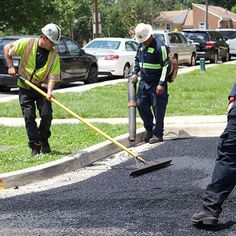
Asphalt paving is a critical component of infrastructure development, providing the foundation for roads, highways, and parking lots that facilitate transportation and commerce. This article explores the asphalt paving process, the materials used, the challenges faced by professionals, and the importance of quality workmanship.
Materials and Preparation
Asphalt paving jobs begin with the preparation of the base soil, which must be properly graded and compacted to ensure a stable foundation. The materials used in asphalt paving typically include a mixture of aggregate (crushed stone, gravel, and sand), binder (usually asphalt cement), and filler.
The Paving Process
The process of laying asphalt involves several steps:
1.
Removing Old Pavement: In cases of resurfacing, the old pavement is removed using milling machines.
2.
Preparing the Subbase: The subbase provides a stable surface to support new pavement and is made of native soil or gravel.
3.
Applying the Binder Layer: The binder layer is composed of large aggregate mixed with oil, providing strength to the pavement.
4.
Laying the Asphalt: Hot asphalt mix is delivered to the site and laid down using a paver machine.
5.
Compaction: Once the asphalt is laid, it's compacted using rollers to ensure durability and a smooth surface.
Challenges in Asphalt Paving
Asphalt paving is not without its challenges. Weather conditions play a significant role; for instance, asphalt must be laid on a dry surface, and extreme temperatures can affect the curing process. Other challenges include ensuring even compaction and dealing with unexpected subbase issues.
Quality and Workmanship
The quality of an asphalt paving job is paramount. Poor workmanship can lead to issues such as potholes, cracks, and uneven surfaces that can be hazardous to drivers and reduce the lifespan of the pavement. Quality workmanship involves:
• Properly preparing the subbase
• Using high-quality materials
• Ensuring even spreading and compaction of asphalt
• Paying attention to details such as edges and transitions
Innovations in Asphalt Paving
The industry is continually innovating to improve the quality and sustainability of asphalt paving. Some of these innovations include:
• Recycled Asphalt Pavement (RAP): Using recycled materials from old pavement reduces waste and is cost-effective.
• Warm-Mix Asphalt: This type of asphalt is produced at lower temperatures, reducing emissions and energy consumption.
• Porous Asphalt: This allows water to drain through the pavement, reducing runoff and improving water quality.
The Importance of Maintenance
Maintenance is crucial for extending the life of asphalt pavement. Regular inspections, sealing cracks, and fixing potholes are all part of a good maintenance regimen. Preventative measures can save money in the long run by avoiding more extensive repairs.
Conclusion
Asphalt paving is more than just laying down a mixture of oil and aggregate; it's an intricate job that requires precision, attention to detail, and a commitment to quality. From the materials chosen to the final compaction, every step in the process contributes to the creation of roads that are safe, durable, and reliable. As the industry evolves with new technologies and methods, the future of asphalt paving looks promising, ensuring that the roads ahead remain the lifelines of our daily lives and economic activities. Remember, a well-paved road is not just a path but a journey to progress and connectivity.




